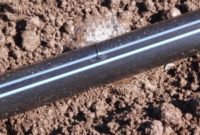Drip irrigation is gaining in popularity because the systems are flexible and can accommodate diverse cropping and application demands. Systems consist of lateral pipes that emit water directly to the root zones of crops, and sub-main pipes that supply water to the laterals. For field and row crop applications, lateral and sub-main pipelines can be classified as seasonal or permanent. They are available in several configurations.

Pros And Cons Of Drip Irrigation System Combinations
Lateral and sub-main components may be combined in different systems for various applications with relative pros and cons. When designing a drip system, factors to consider include crop germination and/or transplant setting, labor, system maintenance requirements, operational flexibility, initial cost, and annual operating cost.
1. Seasonal Laterals And Seasonal Sub-Mains
Pros: These systems are popular in celery or onions, may be
used to germinate the crop, are portable, and have a low initial cost. Because they are expected to last only one season, they require moderate maintenance.
Cons: Labor is needed to move sub-mains and flush laterals.
Plus, there are additional costs for lateral disposal and
lateral replacement.
2. Permanent Laterals With Seasonal Sub-Mains
Pros: Laterals can be used for many years and yet the submains are portable, making this system popular in processing tomato production. Initial system cost is moderate compared to portable vegetable systems, since the laterals are more robust but less expensive than permanent lateral systems.
Cons: Lateral repairs are difficult, there may be a need for
supplemental germination moisture, and there are heavier
maintenance requirements as laterals are expected to last
multiple seasons.
3. Permanent Laterals With Permanent Sub-Mains
Pros: The advantages of drip irrigation systems with permanent laterals with permanent sub-mains (used for field crops) include multi-year use and amortization of both the laterals and sub-mains. Using permanent components also allows automated flushing and eliminates sub-main moving costs.
Cons: Drawbacks include difficult repairs, high maintenance
requirements, the possible need for supplemental moisture for germination, and the need for winterization in cold climates. Initial costs are higher because the components must be durable for multiple-year use and the system must be trenched in.
4. Seasonal Laterals And Permanent Sub-Mains
Pros: This combination is used in vegetable growing regions
to avoid sub-main moving costs.
Cons: Sub-main repairs for these systems are more difficult, as is lateral replacement.
